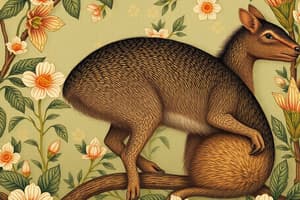Podcast
Questions and Answers
What is a mammal that reproduces by laying eggs?
What is a mammal that reproduces by laying eggs?
- Dolphin
- Platypus (correct)
- Lion
- Kangaroo
What is a characteristic of marsupials?
What is a characteristic of marsupials?
A mammal in which the young have a short period of development within the mother's body.
Which of the following is a characteristic of insectivores?
Which of the following is a characteristic of insectivores?
- Long pointed snouts (correct)
- Living in trees
- Ability to fly
- Strong jaws for cutting flesh
Which mammal usually uses visual navigation rather than echolocation?
Which mammal usually uses visual navigation rather than echolocation?
Carnivores have flat teeth suited for grinding vegetables.
Carnivores have flat teeth suited for grinding vegetables.
What is the largest order of mammals?
What is the largest order of mammals?
Which hoofed mammals are characterized by having an odd number of toes?
Which hoofed mammals are characterized by having an odd number of toes?
Which of these mammals has an even number of toes?
Which of these mammals has an even number of toes?
What are the characteristics of cetaceans?
What are the characteristics of cetaceans?
Primates are known for their ability to communicate, walk upright, and _______.
Primates are known for their ability to communicate, walk upright, and _______.
Flashcards are hidden until you start studying
Study Notes
Monotrema (Monotremes)
- Unique group of mammals that lay eggs instead of giving birth to live young.
- Example: Platypus, notable for its duck-bill and webbed feet.
Marsupialia (Marsupials)
- Characterized by a short gestation period; young continue developing in the mother's pouch.
- Example: Kangaroo, known for its powerful hind legs used for jumping and long tail for balance.
Insectivora (Insect Eaters)
- Distinctive features include pointed snouts and sharp claws for digging.
- Represents a diverse group with few common traits among members.
- Example: Moles, adapted for a life spent underground.
Chiroptera (Bats)
- Primarily rely on visual navigation rather than echolocation, though some species also use sound.
- Example: Fruit bat, known for its large size and fruit-based diet.
Carnivora (Carnivores)
- Equipped with long, sharp canines and incisors for tearing flesh, along with strong jaws.
- Example: Lion, an apex predator celebrated for its hunting abilities in prides.
Rodentia (Rodents)
- Largest order of mammals, capable of surviving in diverse habitats worldwide.
- Possess continuously growing incisors ideal for gnawing.
- Example: Rats, which are adaptable and often found in urban areas.
Perissodactyla (Hoofed Animals with Odd Number of Toes)
- Includes herbivorous mammals with specialized molars for grinding vegetation.
- Example: Horses, recognized for their speed and endurance.
Artiodactyla (Hoofed Animals with Even Number of Toes)
- Comprises large herbivores that often inhabit diverse ecosystems.
- Example: Hippo, one of the largest land mammals, known for its aquatic lifestyle and herbivorous diet.
Cetacea (Whales)
- Highly intelligent marine mammals with large, complex brains and minimal body hair.
- Use blowholes for respiration located on the tops of their heads.
- Example: Dolphin, known for social behavior and advanced learning capabilities.
Primates (Primates)
- Notable for their ability to communicate, walk upright, and use tools.
- Example: Gorillas, large apes that exhibit complex social structures.
Studying That Suits You
Use AI to generate personalized quizzes and flashcards to suit your learning preferences.




